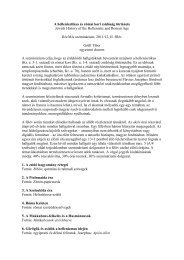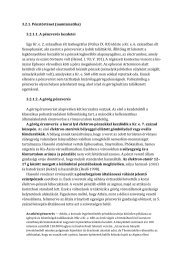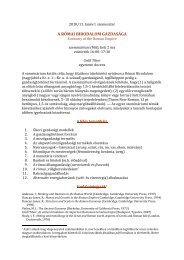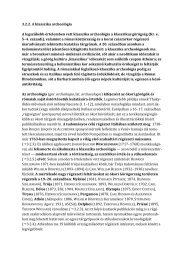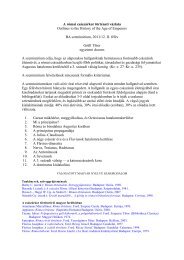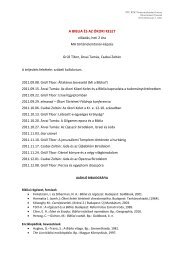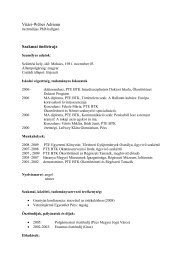A Boleráz, Baden és Kostolac kultúrák kronológiai és térbeli ...
A Boleráz, Baden és Kostolac kultúrák kronológiai és térbeli ...
A Boleráz, Baden és Kostolac kultúrák kronológiai és térbeli ...
You also want an ePaper? Increase the reach of your titles
YUMPU automatically turns print PDFs into web optimized ePapers that Google loves.
as long distance market and trade. In this case, after Sydney W. Mintz the market can be<br />
explained not only as a place for exchanging goods and service, but also as the repository of<br />
social self-adaptation. 4<br />
At the same time, despite all efforts, archaeologist did not succeed to define the exact<br />
date and location when and where the wheel was invented.<br />
Cavalli Sforza and Ammermann argue that the yearly expansion of the Neolithic revolution<br />
was 1 km. 5 (Later the pace was calculated by other scholars and by other methods, but<br />
everybody agreed that this was an extremely rapid process.)<br />
The expansion speed of the wheel and the wagon drive — in my opinion — might<br />
have been similar to the distance that a wagon could reach, and this distance was surely<br />
more than 1 km/day, even if the presumed lack of routes is taken into account. Woodenstave<br />
roads were built between lakeshore settlements, 6 and the Moravian earth mounds were<br />
excavated with wide ramp-entrances, 7 thus, most probably Europe should not be seen as a<br />
roadless wilderness in this period. It is obvious that such exposion-like development cannot<br />
be surveyed by archaeological methods (radiocarbon dates are also not suitable for this<br />
purpose, and dendro-dates are not available at every sites) after such a long period in details,<br />
only at a general level. Thus, these questions will probably be further refined in the next<br />
decades, but most likely the problem will remain unsolved. Moreover, from this aspect,<br />
archaeological research is exposed to lucky finds.<br />
However, improving archaeological methods reveal that greatest developments and<br />
revolutionary improvements cannot be connected to stabile, flowering cultures, but to other<br />
seemingly unimportant, not-named mixed populations (“Misch-Kultur”). Usually, the world<br />
shattering innovations and novelties appear in such dynamic communities which are in<br />
peripheral or semi-peripheral positions. As it was demonstrated in the second part of this<br />
study, the <strong>Baden</strong> culture produced the dense network of connections. This complex was<br />
continuously changing during the life of the culture, considering both the place, object and<br />
direction of the communication.<br />
During its existence the <strong>Baden</strong> culture produced several internal development phases<br />
(IA/B: formation, IIA: from <strong>Boleráz</strong> into <strong>Baden</strong>), flowering (IB/C: classic <strong>Boleráz</strong>, IIB/III:<br />
classic <strong>Baden</strong>), crises (IIA: from <strong>Boleráz</strong> to <strong>Baden</strong>: this process was successful; IV: disastrous<br />
process, disintegration the <strong>Baden</strong> complex), and stagnation (retarding of the <strong>Boleráz</strong> culture<br />
in the <strong>Baden</strong> period, retarding <strong>Baden</strong> parallel with the Early Bronze Age cultures). These<br />
social and economic processes were accompanied by local expansions and contractions. The<br />
centrum/periphery situation inside the <strong>Baden</strong>–complex wandered during the time, as it was<br />
described in the first part of this paper.<br />
Parallel among the contemporaneous core cultures of the Continent (North-Central<br />
Europe: Funnel Beaker culture — a culture having strong megalithic traditions and with<br />
roots in the Neolithic period; East-Central Europe: Cucuteni-Tripolje — an agricultural<br />
civilization, which flowered from the Neolithic period; Eastern Europe: Yamnaja culture — a<br />
herding tribal culture inclined to conquest) the <strong>Baden</strong> civilization was not able to develop<br />
such structures neither in space nor in time, to accomplish such continuity and stability.<br />
Still, its potential for adaption and innovation insured one thousand years of<br />
existence. This openness and success was the result of the cultural and ethnic diversity. It is a<br />
fact, demonstrated on the example of the development of capitalism that business comapies<br />
develop more powerfully, if the political system is not solid behind them (i.e. a strong<br />
empire).<br />
4 MINTZ 1959, 20.<br />
5 AMMERMAN – CAVALLI SFORZA 1974..<br />
6 PÉTREQUIN et al. 2006.<br />
7 BALDIA et al. 2008.<br />
2





